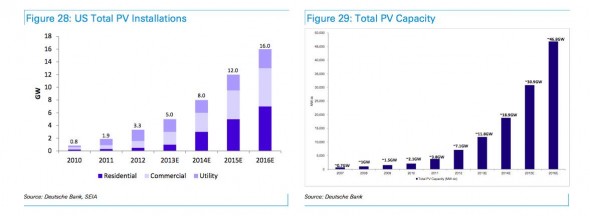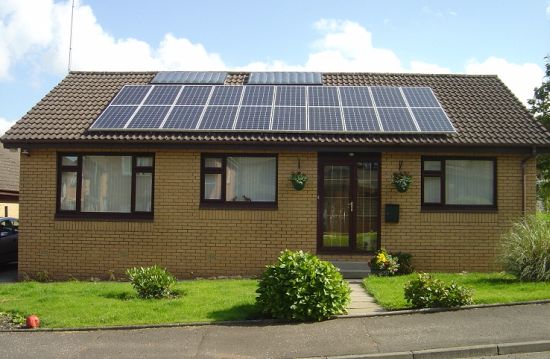 Deutsche Bank has released a new report predicting that rooftop solar will reach “grid parity” in all 50 states of the U.S. in just two years–by the end of 2016. “Grid parity” means that the cost of obtaining electricity from rooftop solar–including installation–is equal to or less than the cost of obtaining electricity from traditional utilities operating in the state.
Deutsche Bank has released a new report predicting that rooftop solar will reach “grid parity” in all 50 states of the U.S. in just two years–by the end of 2016. “Grid parity” means that the cost of obtaining electricity from rooftop solar–including installation–is equal to or less than the cost of obtaining electricity from traditional utilities operating in the state.
This startling conclusion came in an analysis by the Bank’s Vishal Shah, considered a leading solar analyst, of the prospects of Vivint Solar. Vivint is the second largest installer of rooftop solar systems in the U.S. although it currently operates in just seven states. While Deutsche Bank is more bullish on solar prospects that some other investment analysts, as we have been reporting all year just above every major investment firm has released at least one study touting solar’s rapid growth and warning utilities to prepare.
Just a year ago, a Deutsche Bank analysis said 10 U.S. states already have achieved grid parity, and predicted that 36 states would do so by 2016 if the investment tax credit (ITC) for solar is dropped to 10%, as current law states. If the ITC were renewed at the 30% rate it now enjoys–and as the solar industry says it will fight for–the bank at that time predicted that 47 states would reach parity by 2016.
As the graph at the top of the page indicates, Deutsche Bank believes U.S. solar rooftop installations will double over the next two years, from an estimated 8 GW this year to 16 GW in 2016. That would put total U.S. solar rooftop capacity at nearly 50 GW by the end of 2016–or about 2% of total U.S. electrical capacity. That’s still a small number, but that’s the kind of growth that makes traditional utilities very, very nervous. That means hundreds of thousands to millions of customers–not just tens of thousands spread out across the country–generating their own power. And there is no reason to believe the growth rate will suddenly stop in 2016. More likely the rapid growth will continue.

And when you get to the point where millions are doubling their numbers every 2-3 years, you attain potential serious erosion in utilities’ customer bases–especially when you add to rooftop installations battery storage capability which means homeowners can provide their own power 24/7. As we reported last week, battery storage may be the “new solar” in terms of cost reduction over the next several years. A Bloomberg News report published after our post last week argues that battery storage remains too expensive at present to be practical for homeowners, but that is likely to change within two years.
The projected solar growth, and thus threat to traditional utilities, is particularly significant since, while we have not seen the full new Deutsche Bank analysis, according to reports like this one the Bank apparently does not see the ITC issue as crucial to continued rapid solar growth. Instead, its projection is “based on a continued fall in installation costs of solar, the cheaper cost of finance as new financial models attract more mainstream funding, and assuming that the attempts by utilities to curtail the proliferation of solar are resisted.”
This last factor is critical–and it is the one where activists everywhere can help ensure a clean energy future. Instead of reducing or eliminating renewable energy standards, or replacing them with phony “clean energy” standards that include nuclear power, activists can and should press for expanding such standards and keeping nuclear far away from them. The issue will also arise as states act to implement the EPA’s Clean Power Plan beginning sometime next year. In many states these will be huge battles, with a lot of money and misinformation flowing. Activists will need to fight back with accurate information and numbers–in this case numbers means people: the vast majority of Americans support renewable energy and solar power in particular. They want solar to succeed; it’s a matter of reaching out and mobilizing them. That’s what we’re good at. That’s our expertise. Let’s do it.
Michael Mariotte
October 28, 2014
Permalink: https://www.nirs.org/2014/10/28/rooftop-solar-will-be-cheaper-option/
Your contributions make publication of GreenWorld possible. If you value GreenWorld, please make a tax-deductible donation here and ensure our continued publication. We gratefully appreciate every donation of any size.
Comments are welcome on all GreenWorld posts! Say your piece above. Start a discussion. Don’t be shy; this blog is for you.
If you’d like to receive GreenWorld via e-mail, send your name and e-mail address to nirs@nirs.org and we’ll send you an invitation. Note that the invitation will come from a GreenWorld@wordpress.com address and not a nirs.org address, so watch for it.
If you like GreenWorld, you can help us reach more people. Just use the icons below to “like” our posts and to share them on the various social networking sites you use. And if you don’t like GreenWorld, please let us know that too. Send an e-mail with your comments/complaints/compliments to nirs@nirs.org. Thank you!
GreenWorld is crossposted on tumblr at https://www.tumblr.com/blog/nirsnet




Reblogged this on your passport to complaining and commented:
While the forecasts are interesting, what i did not realize was that solar was already at grid parity in 10 US states.